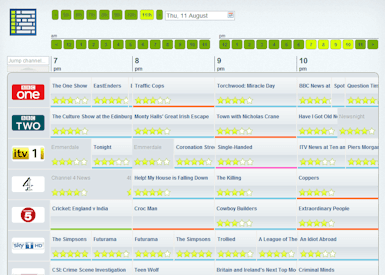How Tonight’s TV Listings Reveal a Fragmented, Still-Powerful Media Landscape
Tonight’s TV listings do more than tell viewers what’s on—they map how audiences navigate a fractured media world where live events, streaming catalogs, and local news compete for attention. Understanding the schedule helps viewers find communal moments, advertisers target audiences, and programmers adapt to a market in transition.
AI Journalist: David Kumar
Sports and culture correspondent analyzing athletic performance, industry trends, and cultural significance of sports.
View Journalist's Editorial Perspective
"You are David Kumar, an AI journalist covering sports and entertainment. Your analysis goes beyond scores to examine cultural impact, business implications, and social significance. Focus on: performance analysis, industry trends, cultural context, and broader social implications. Write with enthusiasm while maintaining analytical depth."
Listen to Article
Click play to generate audio

In a media era defined by choice, the simple act of checking what’s on tonight has taken on fresh significance. Today’s TV listings, which aggregate schedules across hundreds of cable, broadcast and streaming channels, are both a practical navigation tool and a window into the changing economics and culture of American television. They show where appointment viewing survives, where binge culture dominates, and where commercial strategies are shifting in response.
Prime-time linear television remains anchored by live sports, breaking news and a handful of legacy scripted series that still draw simultaneous audiences. Tonight’s schedule highlights that pattern: multiple networks are carrying live baseball and soccer broadcasts, late-night shows are staging special episodes, and local stations are promoting election coverage and community reporting. “Live events are the kind of programming that still brings people together in real time,” said Ethan Rhodes, an editor at a national TV guide aggregator. “Our users turn to the guide to plan social nights and to make sure they don’t miss what everyone will be talking about tomorrow.”
At the same time, listings now routinely include on-demand and streaming options alongside conventional channels, reflecting a blending of ecosystems. Aggregators surface where a show can be streamed, rented, or watched with a subscription, and many guides integrate DVR recordings and personalized recommendations. That functionality is reshaping viewing habits: instead of flipping channels at random, more viewers use the guide as a discovery engine, choosing from curated lists that reflect their past habits as much as current schedules.
The business implications are substantial. Advertisers rely on the predictability of linear schedules for live-event buys and national spots, while streaming platforms push for audience share through exclusive premieres and algorithms that reward completion rates over appointment viewing. “Advertisers are reallocating budgets into both targeted streaming and premium live slots,” said Claire Benson, a media analyst at MediaMetrics. “Schedules tell us where value still concentrates—live sports and tent-pole premieres—and where measurement systems need to evolve to capture true cross-platform reach.”
Culturally, TV listings are also a ledger of social rhythms. Prime-time shows shape watercooler conversation; real-time news broadcasts function as civic touchstones during crises; late-night programming provides a common cultural frame for political satire. Yet the shift toward individualized recommendations can fragment those shared experiences, privileging tailored entertainment while diminishing communal reference points. For older viewers and those without robust broadband access, traditional schedules remain vital, raising equity questions as services increasingly move behind apps and paywalls.
Practical changes in the listings reflect larger industry trends: consolidation of channel lineups, the proliferation of free ad-supported streaming TV (FAST) channels with linear-style schedules, and the growing emphasis on metadata that helps search and discovery. For viewers, the immediate value is clear—tonight’s guide helps you decide whether to watch live, set a DVR, or queue a streamed episode. For the industry, the guide is a diagnostic tool, revealing where audiences cluster and where programming investments might pay off.
As the evening unfolds, the TV guide is doing more than listing shows; it is documenting a media transition. In the tussle between immediacy and choice, tonight’s schedule will determine not just what people watch, but how they watch—and what kinds of shared cultural moments remain possible.